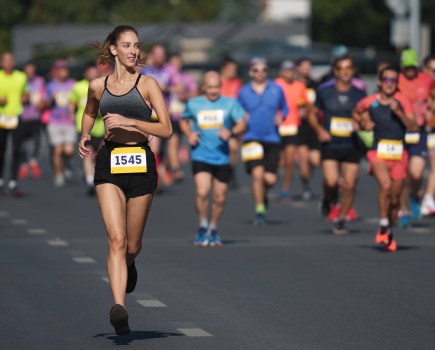Learn how to power through 26.2 miles and avoid hitting the wall during a marathon with these top tips and fueling essentials from Science in Sport.
You’re powering past the mile 20 marker, a spring in your step and a smile on your face, when all of a sudden, your legs have turned to stone and no amount of effort can summon them to continue. Yep: you’ve hit the dreaded wall. If you’re gearing up for your next marathon, and you want to learn how to avoid hitting the wall this time around, you’ve come to the right place.
Why do so many marathon newbies find themselves facing the dreaded wall? Well, in most cases, it all comes down to a lack of preparation – during your training runs, fueling plan or both. If you’re looking to become a regular marathoner, you need to start training smarter and understanding how best to fuel your body, so you can avoid hitting the wall for the whole 26.2 miles.
How to avoid hitting the wall during a marathon:
There are many steps you can take to give yourself the best chance of beating the wall. Here are some quick training and fueling tips to keep in mind before your next marathon…
- Take on extra carbohydrates and hydration during race week. Try the Science in Sport GO Electrolyte Powder, which offers the perfect mix for carb loading and hydration.
- Plan in advance how you will fuel yourself during the race. Alongside regular hydration top-ups, you might choose to have a Science in Sport GO Isotonic Energy Gel every 30 – 45 minutes, or snack on half of a Science in Sport GO Energy Bar every 7- 8 miles. Trial and error are key – experiment with timings during your long practice runs to find what works best for you.
- Everything is easier when you are enjoying it, so try your best to stay positive and run with a smile. If you really can’t find enjoyment during those tough middle miles, go to your happy place by thinking of something else that brings you joy.
- Finally, trust your training. You’ve put the hard work in for the past 16-20 weeks – this one last run is your victory lap!

How to fuel your body on marathon day
If you want to avoid hitting the wall during your marathon, smart fueling before, during and after your run is key.
Pre-race fueling: carb loading and caffeine
You’ll often hear runners going on about carb loading the night before a race, but it’s not merely an excuse to chow down on a pile of pasta. Carbohydrate loading is an important method to enhance marathon performance. Why? Because it allows the marathon runner to run at their optimal pace for an extended period before resulting in fatiguing.
So, how many carbs are we talking? Generally speaking, runners should consume sufficient carbohydrate to restore glycogen stores between each training session. It is recommended to intake 10–12 g/kg/day of carbohydrate 36-48 hours prior to the race. On the morning of your race, your breakfast should consist of carbs such as, cereals, bagels, toast, fruit juice and jam.
It’s also important to consume your breakfast 1-3 hours before the race, so you have time to digest it before you set off. Gastrointestinal issues are the last thing you want to be dealing with when you’ve got an entire marathon to run! Before the starting horn, you could also consider taking 3-6mg/kg of caffeine, which could be in the form of a SiS GO Energy + Caffeine gel to reduce and delay the onset of fatigue.
In-race fueling: energy gels and hydration
Just because the race is underway, it doesn’t mean you can forget all about fueling. Throughout the race you’ll need to plan mini pit stops so you can top up your energy supply. Be sure not to wait too long to top up the tank – fueling during the race should begin in the first hour of your marathon, to avoid hitting the wall early. The recommended amount of carbohydrate intake per hour is 60-90g, which equates to around 3-4 SiS GO Energy gels.
Don’t forget about hydration. Your sweat rate is greatly accelerated during a marathon, so it is important to replace fluid losses while racing. You should take a combination of fluid and carbohydrates alongside each other.
Lastly, if you feel yourself flagging, you could take 3-6mg/kg of caffeine gel during the last hour of the marathon to decrease fatigue to further avoid hitting the wall.
Post-race recovery: replenish glycogen stores and rehydrate
Once you make it to the end of your marathon (without hitting the wall – congrats!), it’s important to help your body refuel and recovery. Running a marathon will deplete your glycogen stores, cause muscle damage and can result in fluid loss. You should focus on rehydrating while also ingesting carbohydrates and protein to replenish glycogen stores and to promote protein synthesis.
A simple solution to kickstart the recovery process would be to consume SiS REGO Rapid Recovery within 30 minutes of finishing the event, as it contains both carbohydrate and protein.
Avoid hitting the wall with Beta Fuel
The Science in Sport Beta Fuel Dual Source Energy Drink delivers an optimised 80g of carbohydrate in a single, convenient isotonic fuelling solution. There’s also minimal risk of GI discomfort, allowing you to maintain optimal performance for the duration of your race.
If you want to avoid hitting the wall during your marathon, try using one powder sachet per hour. Or, you could combine these with Beta Fuel Gels or Chew Bars to hit a higher hourly 80-120g carbohydrate intake as required.
Find out more about Science in Sport at scienceinsport.com








